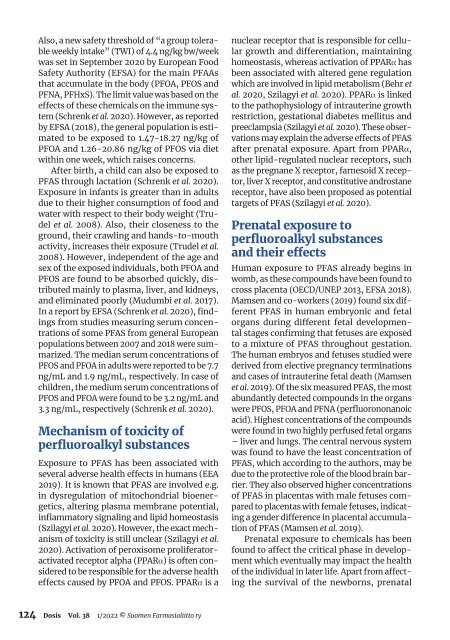DOSIS 1/2022
Farmaseuttinen aikakauskirja DOSIS 4/2021 vol.37 5uomen Farmasialiitto ry
Farmaseuttinen aikakauskirja DOSIS 4/2021 vol.37 5uomen Farmasialiitto ry
Create successful ePaper yourself
Turn your PDF publications into a flip-book with our unique Google optimized e-Paper software.
Also, a new safety threshold of “a group tolerable<br />
weekly intake” (TWI) of 4.4 ng/kg bw/week<br />
was set in September 2020 by European Food<br />
Safety Authority (EFSA) for the main PFAAs<br />
that accumulate in the body (PFOA, PFOS and<br />
PFNA, PFHxS). The limit value was based on the<br />
effects of these chemicals on the immune system<br />
(Schrenk et al. 2020). However, as reported<br />
by EFSA (2018), the general population is estimated<br />
to be exposed to 1.47-18.27 ng/kg of<br />
PFOA and 1.26-20.86 ng/kg of PFOS via diet<br />
within one week, which raises concerns.<br />
After birth, a child can also be exposed to<br />
PFAS through lactation (Schrenk et al. 2020).<br />
Exposure in infants is greater than in adults<br />
due to their higher consumption of food and<br />
water with respect to their body weight (Trudel<br />
et al. 2008). Also, their closeness to the<br />
ground, their crawling and hands-to-mouth<br />
activity, increases their exposure (Trudel et al.<br />
2008). However, independent of the age and<br />
sex of the exposed individuals, both PFOA and<br />
PFOS are found to be absorbed quickly, distributed<br />
mainly to plasma, liver, and kidneys,<br />
and eliminated poorly (Mudumbi et al. 2017).<br />
In a report by EFSA (Schrenk et al. 2020), findings<br />
from studies measuring serum concentrations<br />
of some PFAS from general European<br />
populations between 2007 and 2018 were summarized.<br />
The median serum concentrations of<br />
PFOS and PFOA in adults were reported to be 7.7<br />
ng/mL and 1.9 ng/mL, respectively. In case of<br />
children, the medium serum concentrations of<br />
PFOS and PFOA were found to be 3.2 ng/mL and<br />
3.3 ng/mL, respectively (Schrenk et al. 2020).<br />
Mechanism of toxicity of<br />
perfluoroalkyl substances<br />
Exposure to PFAS has been associated with<br />
several adverse health effects in humans (EEA<br />
2019). It is known that PFAS are involved e.g.<br />
in dysregulation of mitochondrial bioenergetics,<br />
altering plasma membrane potential,<br />
inflammatory signaling and lipid homeostasis<br />
(Szilagyi et al. 2020). However, the exact mechanism<br />
of toxicity is still unclear (Szilagyi et al.<br />
2020). Activation of peroxisome proliferatoractivated<br />
receptor alpha (PPARα) is often considered<br />
to be responsible for the adverse health<br />
effects caused by PFOA and PFOS. PPARα is a<br />
nuclear receptor that is responsible for cellular<br />
growth and differentiation, maintaining<br />
homeostasis, whereas activation of PPARα has<br />
been associated with altered gene regulation<br />
which are involved in lipid metabolism (Behr et<br />
al. 2020, Szilagyi et al. 2020). PPARα is linked<br />
to the pathophysiology of intrauterine growth<br />
restriction, gestational diabetes mellitus and<br />
preeclampsia (Szilagyi et al. 2020). These observations<br />
may explain the adverse effects of PFAS<br />
after prenatal exposure. Apart from PPARα,<br />
other lipid-regulated nuclear receptors, such<br />
as the pregnane X receptor, farnesoid X receptor,<br />
liver X receptor, and constitutive androstane<br />
receptor, have also been proposed as potential<br />
targets of PFAS (Szilagyi et al. 2020).<br />
Prenatal exposure to<br />
perfluoroalkyl substances<br />
and their effects<br />
Human exposure to PFAS already begins in<br />
womb, as these compounds have been found to<br />
cross placenta (OECD/UNEP 2013, EFSA 2018).<br />
Mamsen and co-workers (2019) found six different<br />
PFAS in human embryonic and fetal<br />
organs during different fetal developmental<br />
stages confirming that fetuses are exposed<br />
to a mixture of PFAS throughout gestation.<br />
The human embryos and fetuses studied were<br />
derived from elective pregnancy terminations<br />
and cases of intrauterine fetal death (Mamsen<br />
et al. 2019). Of the six measured PFAS, the most<br />
abundantly detected compounds in the organs<br />
were PFOS, PFOA and PFNA (perfluorononanoic<br />
acid). Highest concentrations of the compounds<br />
were found in two highly perfused fetal organs<br />
– liver and lungs. The central nervous system<br />
was found to have the least concentration of<br />
PFAS, which according to the authors, may be<br />
due to the protective role of the blood brain barrier.<br />
They also observed higher concentrations<br />
of PFAS in placentas with male fetuses compared<br />
to placentas with female fetuses, indicating<br />
a gender difference in placental accumulation<br />
of PFAS (Mamsen et al. 2019).<br />
Prenatal exposure to chemicals has been<br />
found to affect the critical phase in development<br />
which eventually may impact the health<br />
of the individual in later life. Apart from affecting<br />
the survival of the newborns, prenatal<br />
124 Dosis Vol. 38 1/<strong>2022</strong> © Suomen Farmasialiitto ry

















